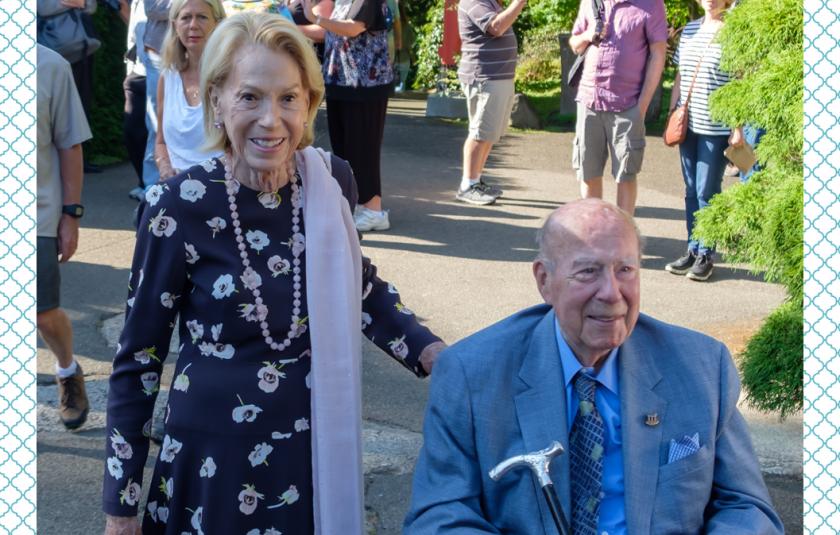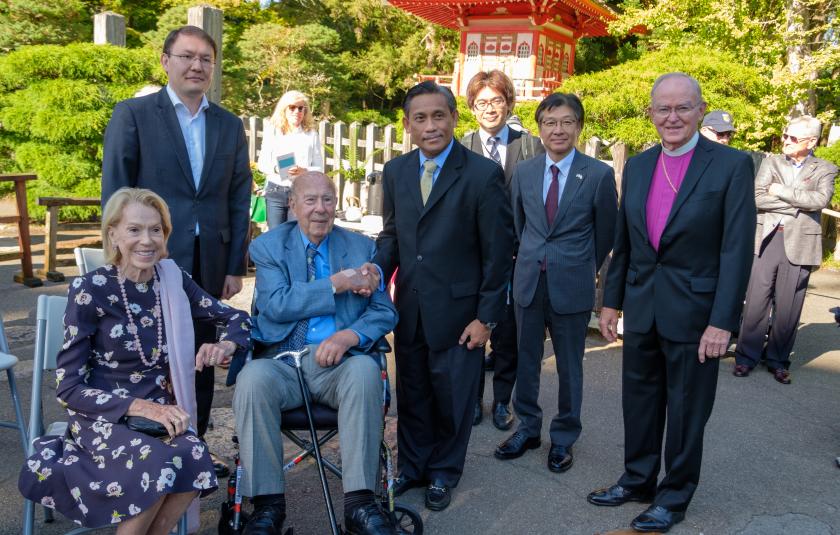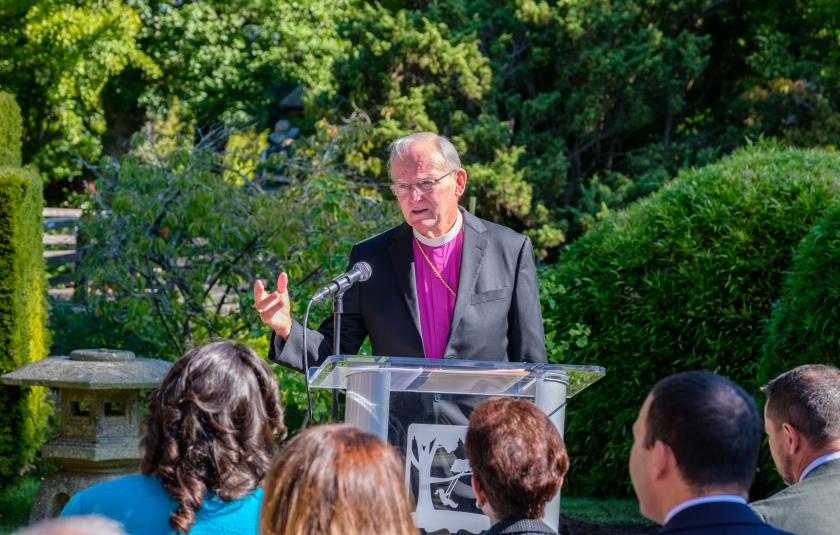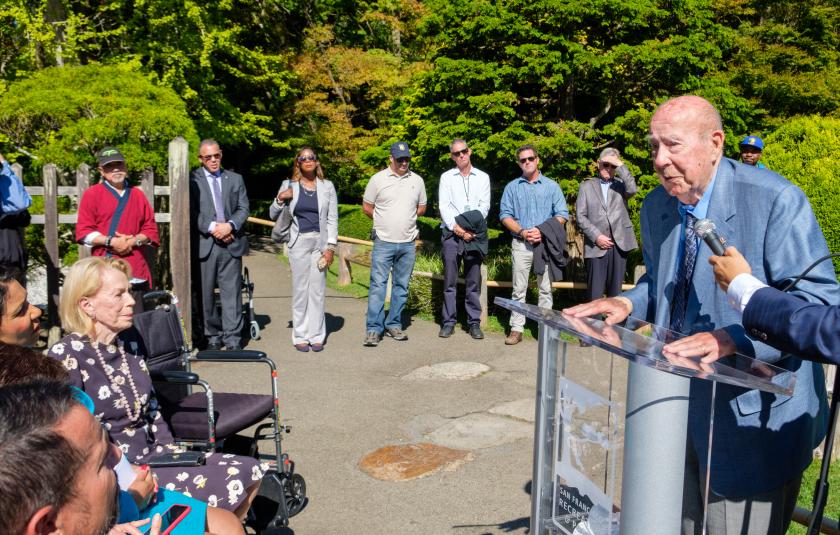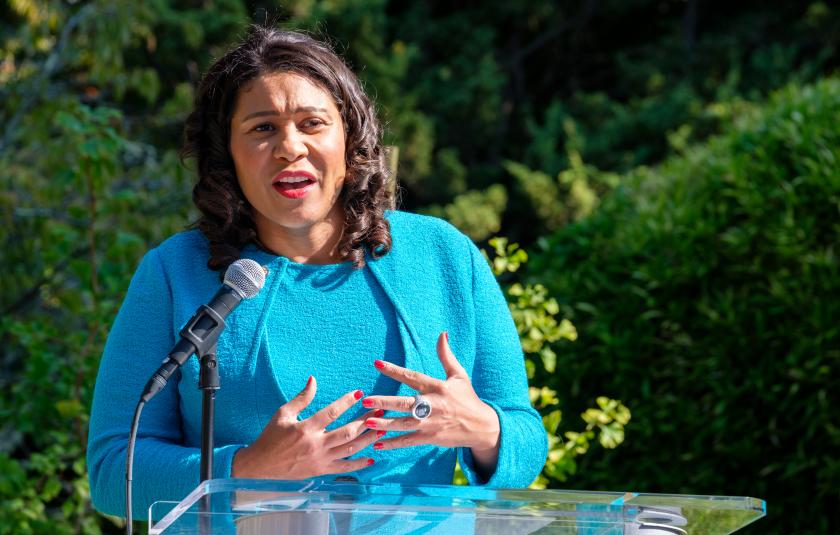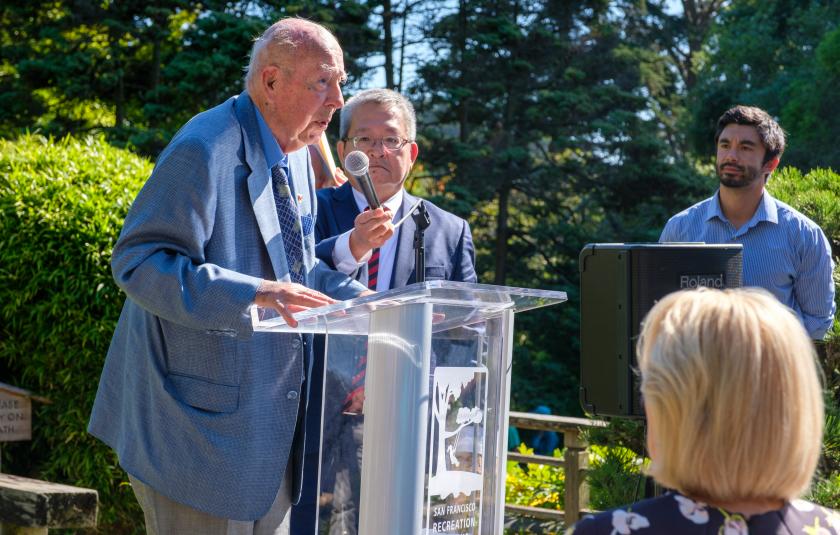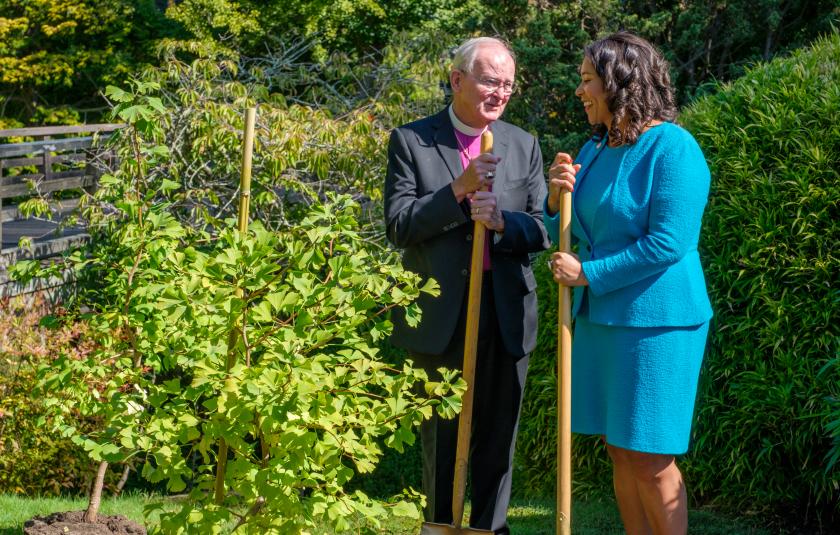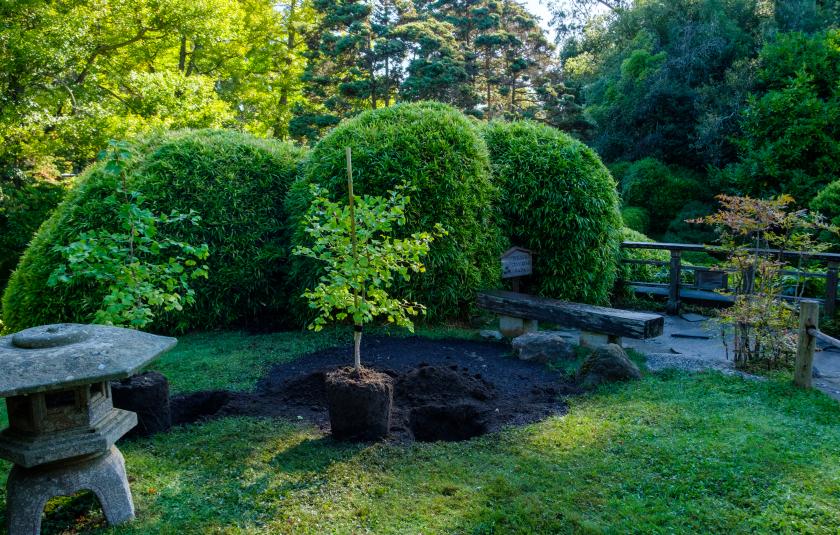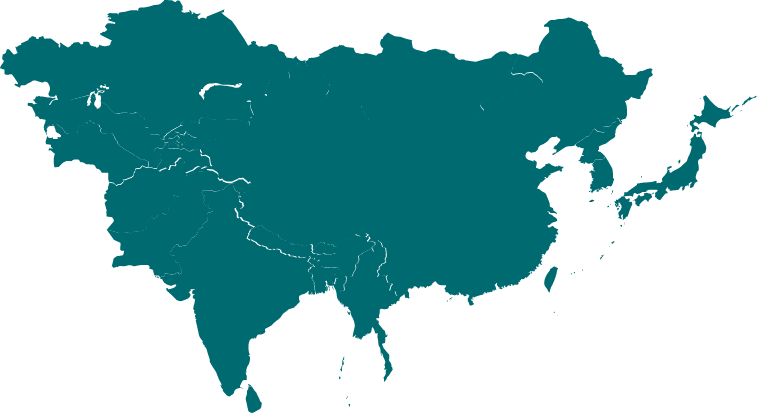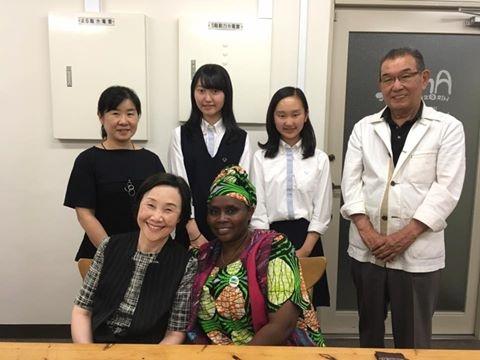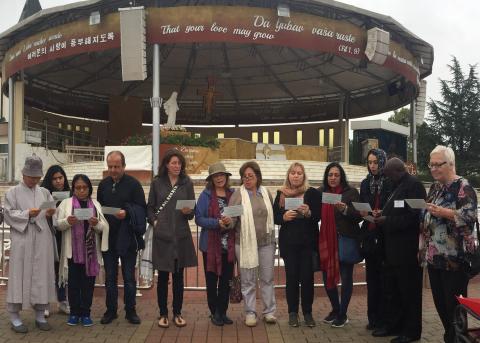George and Charlotte Shultz Honored for Disarmament Work
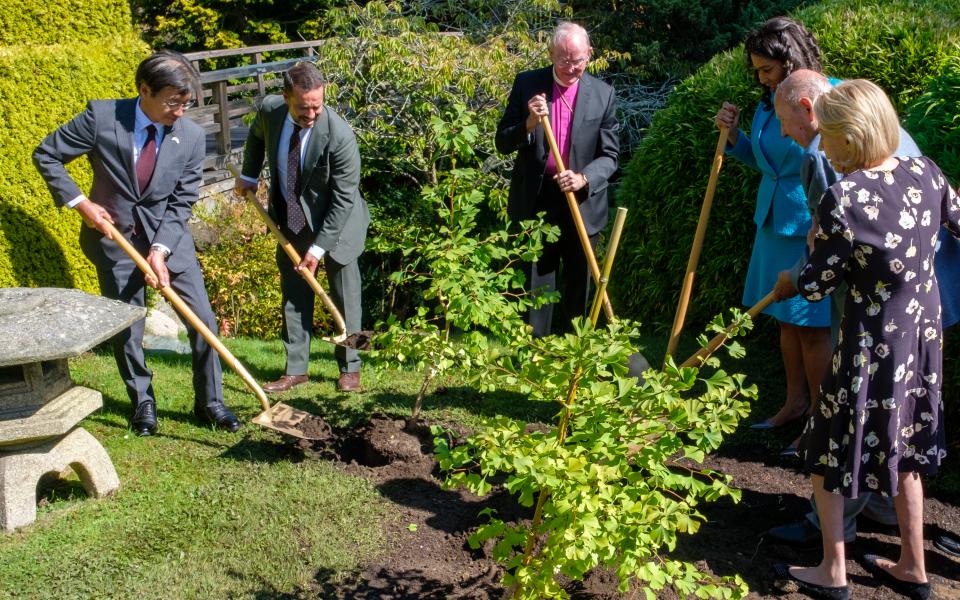
Planting the trees, from left: Deputy Consul General Kazuhiro Iryu, Japan; San Francisco Recreation and Park Department General Manager Phil Ginsburg; President and Founding Trustee of URI, The Right Rev. William E. Swing; San Francisco Mayor London N. Breed; former U.S. Secretary of State George P. Shultz; Dame Charlotte Mailliard Shultz.
SAN FRANCISCO – Two second-generation saplings—descendants of ginkgo trees that survived the nuclear blast on Hiroshima—were planted at the Japanese Tea Garden today in a ceremony that also honored former U.S. Secretary of State George Shultz and Dame Charlotte Mailliard Shultz for their advocacy around nuclear disarmament.
URI (United Religions Initiative), a global grassroots interfaith organization, held the ceremonial planting in conjunction with the United Nations’ International Day for Peace (Sept. 21) and its International Day for Total Elimination of Nuclear Weapons (Sept. 26).
“These trees represent our City’s commitment to the health and safety of our planet,” said San Francisco Mayor London N. Breed. “For generations to come, San Francisco residents and visitors will be able to visit these trees in the Japanese Tea Garden and reflect on the importance of a nuclear-free future.”
The trees join seeds and saplings from the A-bombed trees growing in more than 20 countries as part of the effort for a nuclear-free planet. Green Legacy Hiroshima, which is a part of URI Cooperation Circle (member organization) ANT-Hiroshima, shares worldwide the double message of caution and hope that the unique survivor trees of Hiroshima (and ultimately Nagasaki) represent, recalling, on the one hand, the dangers of arms of mass destruction and nuclear weapons in particular, and, on the other hand, the sacred character of mankind and the resilience of nature. “These trees will stand here as a symbol of abiding peace between our two countries and a symbol of a world free of nuclear weapons,” said President and Founder of URI, The Right Rev. William E. Swing. “So it is fitting that we honor this unique and praiseworthy couple, with trees that have withstood this planet’s hottest test. The George and Charlotte Shultz Peace Grove of the Japanese Tea Garden will stand tall in San Francisco.”
- See the full text of The Right Rev. William E. Swing's speech here.
The Japanese Tea Garden, located in Golden Gate Park, is the oldest public Japanese garden.
“We are honored to have these survivor trees grow and thrive here in this special place for the Japanese American community and all San Franciscans,” said San Francisco Recreation and Park General Manager Phil Ginsburg. “They will stand not only for peace, but as a living honor to George and Charlotte Shultz and their work around disarmament.”
URI is a global grassroots interfaith network that cultivates peace and justice by engaging people to bridge religious and cultural differences and work together for the good of their communities and the world. Local groups called Cooperation Circles connect to a global network that amplifies impact. URI’s network comprises 1018 Cooperation Circle in 108 countries.
About URI (United Religions Initiative)
URI is a global grassroots interfaith network that cultivates peace and justice by engaging people to bridge religious and cultural differences and work together for the good of their communities and the world. Local groups called Cooperation Circles connect to a global network that amplifies impact. URI’s network comprises 1018 Cooperation Circle in 108 countries.
A URI Cooperation Circle is a self-organizing group of at least seven members from at least three religions, spiritual expressions, or indigenous traditions—including atheists and agnostics. Cooperation Circles work on two levels: by giving people of different backgrounds a chance to work together, and by tackling important community issues their members care about.
Working together, groups of URI members from diverse traditions create inclusive, on-the-ground solutions in areas that have been identified by their communities as crucial for the health, happiness, and success of all people living there. Projects and programs undertaken by our Cooperation Circles serve one or more of the 14 Action Areas.
Why the tree planting in the Japanese Tea Garden?
The trees are second-generation samplings from Hiroshima, post the detonation of a nuclear weapon on the city. Green Legacy Hiroshima, which is a part of URI Cooperation Circle (member organization) ANT-Hiroshima, is a global volunteer campaign, aiming to disseminate the universal message of trees that survived the atomic bombing of Hiroshima. Created in 2011 by two friends, Nassrine Azimi and Tomoko Watanabe, GLH shares worldwide the double message of caution and hope that the unique survivor trees of Hiroshima (and ultimately Nagasaki) represent, recalling, on the one hand, the dangers of arms of mass destruction and nuclear weapons in particular, and, on the other hand, the sacred character of mankind and the resilience of nature. Currently, seeds and saplings from the A-bombed trees are growing in more than 30 countries - in a sustained, long-term (1000-year) campaign, joining other efforts for a nuclear-free and more ecological planet.
Nuclear Disarmament
The date of September 20 was chosen because of its proximity to September 21, the United Nation’s International Day of Peace and September 26, the United Nation’s International Day for Total Elimination of Nuclear Weapons The International Day of Peace was established in 1981 by the United Nations General Assembly. Two decades later, in 2001, the General Assembly unanimously voted to designate the Day as a period of non-violence and cease-fire. The United Nations invites all nations and people to honor a cessation of hostilities during the Day, and to otherwise commemorate the Day through education and public awareness on issues related to peace. URI has been a key partner alongside the UN in the last 20 years, promoting this day throughout its network.
The U.N. General Assembly commemorates 26 September as the International Day for the Total Elimination of Nuclear Weapons. Achieving global nuclear disarmament is one of the oldest goals of the United Nations. It was the subject of the General Assembly’s first resolution in 1946, which established the Atomic Energy Commission, which was dissolved in 1952, with a mandate to make specific proposals for the control of nuclear energy and the elimination of atomic weapons and all other major weapons adaptable to mass destruction. The United Nations has been at the forefront of many major diplomatic efforts to advance nuclear disarmament since. In 1959, the General Assembly endorsed the objective of general and complete disarmament. In 1978, the first Special Session of the General Assembly Devoted to Disarmament further recognized that nuclear disarmament should be the priority objective in the field of disarmament. Every United Nations Secretary-General has actively promoted this goal. Yet, today nearly 14,000 nuclear weapons remain.
Honoring George and Charlotte Shultz
The Hon. George P. Shultz and Dame Charlotte Mailliard Shultz have been avid supporters of URI from the inception – from hosting the very first Global Council of Trustees reception at their residence to participating on the URI Presidents Council.
The Hon. George P. Shultz is a key spokesperson for the disarmament and removal of nuclear weapons in the world. As such, he is a prominent member of the Voices for a World Free of Nuclear Weapons, a Cooperation Circle (member organization) of URI.
